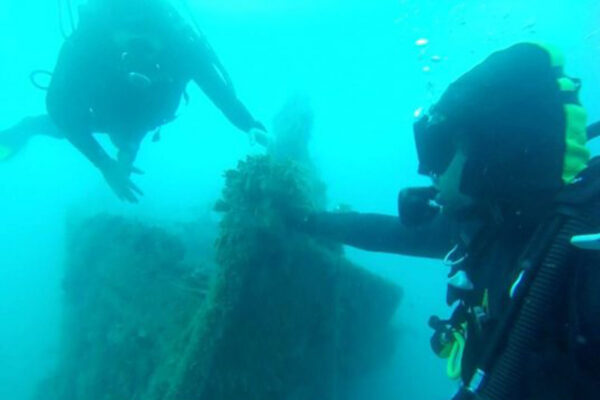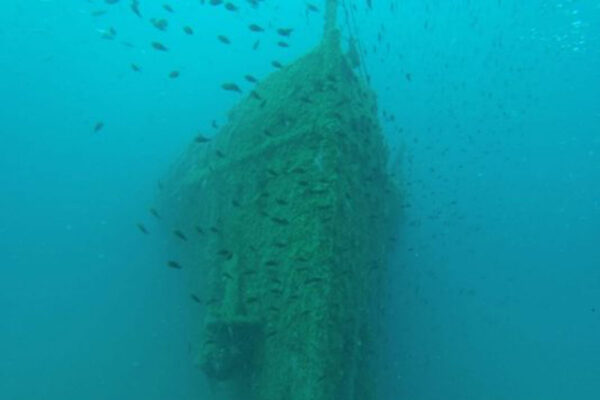Albania’s maritime space is the resting place of dozens of warships sunk during the two world wars and after the end of the Cold War, relics protected by international conventions and maritime traditions – often honored as underwater cemeteries.

In our naval waters there are over 60 ships, sunk in military operations during the two World Wars, but also in the period after the Cold War.
Currently, they cannot be turned into underwater attraction facilities for enthusiastic divers due to international conventions, but also due to the lack of coordination between Albanian institutions.
In the last 20 years, some of them have fallen prey to predatory divers, who, with the help of the state’s indifference, have turned sailing vessels into important historical values, almost into ironworks.
“We aim to improve the current legislation that regulates the competencies and responsibilities for the detection, preservation and conservation of objects belonging to our cultural heritage at sea,” he told BIRN. the commander of our Naval Force, Artur Meçollari, on whose initiative the first Coordination Meeting with representatives of the line ministries and institutions on the maritime underwater heritage was organized in Durrës on Friday.
According to Meçollari, of the 64 ships sunk off the Albanian coast, most belong to two world wars, 1914-1918 and 1939-1945, while 19 others are ships of our Navy during the Cold War, which sank. for various reasons after the 1990s.
The latest UNCLOS III international conventions, to which our country also adheres, have set a 100-year period during which the rights to sunken ships come together, such as the flagship state of the vessel and the country to which the marine waters belong. the ship is located.
Maritime tradition and customary law consider it a human obligation to respect the sunken ships, which are often called human cemeteries with a special spiritual connection to the flag state.
According to underwater archaeologist Adrian Anastasi, the Albanian party’s contributor to the drafting of the 2008 Convention, the wickedness of predators and not the law has operated under water for the past two decades.
Anastasi gives the example of the uncontrolled exploration of the cruiser “Lika” in the bay of Durrës, for example, or the destroyer “Intrepido” and the hospital ship “Yes” in Vlora, which have caused serious damage to their historical values. This also happened when foreign divers intervened in the sunken ships after the agreements with the Albanian side.
Referring to 26 ships sunk a century ago during the First World War, dr. Anastasi adds that one should not speculate on the passage of the 100-year underwater period.
“Although the rights to these ships are running out, they should not be moved from place to place without completing the in situ study process, which will prove the true values and history of the vessel,” he said.
Meanwhile, the locations of millennial objects of archeological importance under the sea have been excluded from the maps compiled by the Navy to avoid the serious abuses that have occurred before in the territorial waters in front of the coastal cities.
Dr. Ilir Çapuni has come from Ulcinj to attend the coordination meeting on underwater heritage, and his experience as a professional diver in national and international expeditions is expected with interest by the participants. He shares the same opinion with his colleague from Durrës about the scientific importance of the study, but also underlines the urgent need for a National Maritime Museum.
“In recent years, Croatia has opened four maritime museums in as many cities, and has launched a number of sunken ships off its shores,” said Ilir Capuni.
“A 2-year moratorium was enough, as well as participation in major international projects to create a previously unknown museum network, quite attractive to foreign tourists,” he added.
The Ulcinj diver underlined that the material that is still under water in front of the shores of Albania “enables the opening of at least three museums, even in Ulcinj, which must prove the truth of tradition in the field of maritime since the time of the Illyrians, but also that of fishing.
“Unfortunately, in the stands of the Maritime Museum in Kotor (Montenegro), where the stands of the Ulcinj tradition are located, the curators of the museum still write” the enemy ships of the Albanians “, said Çapuni, who is also the chairman of the Municipal Assembly of Ulcin.

Gjet Ndoj, director of the general directorate of culture development policies at the Ministry of Culture, stressed the importance of inventorying underwater heritage sites.
“We already have an institute for the registration of heritage sites, and this national register must contain the” passports “of vessels and objects of any kind that have been sunk in the last 100 years, but also the earliest ones with archaeological values.” he said.
“This will increase responsibility and increase cooperation between institutions,” Ndoj added, praising the Navy’s initiative.
The museumization of relics under water or on land continues to be just a good wish in a place like ours with about 6,200 square kilometers of territorial sea and with a total maritime space of 11 thousand square kilometers. The institutions acknowledge that despite the early Illyrian and Albanian tradition in this field, there is currently no real maritime museum in our country.
The 105th episode, as it was called in the feature film “Face to Face”, continues to attract the attention of the generation that came of age during the communist regime.
“The vehicle has been restored and is located in the Naval Base of Pasha Limani, but together with the poor conditions of the road infrastructure, the visits to the Base create a problem for security. After a contract that gives the right of management to the Ministry of Culture, now it is returning to the Ministry of Defense, “said Commander Meçollari, who sees her future in Vlora.
“Despite the high costs of transfer and exposure, it could be an important part of the future Maritime Museum,” he added.
He announced on Friday the proposal to turn the former school of the Navy in Vlora into a national museum where our 2-thousand-year-old naval heritage can be exhibited. The school has a total area of 27 thousand square meters, while its functional area reaches 3,400 square meters.
After the positive experience of 2001, when the first underwater park was created on the shores of Saranda, where six warships that came out of the inventory sank, the Marine Command proposed on Friday the creation of three more parks in Radhima, in Cape e. St. John’s (Karaburun) and Cape Paul (Durres). According to Commander Meoçllari, “the depths of 20-25 meters make them very attractive for tourists, who can easily reach the land in front of the parks.
An underwater park with ships that do not pose a risk and add biodiversity at the same time addresses passionate tourists away from valuable ships and who are protected by international conventions.
Commander Artur Meçollari wishes that this coordination meeting paves the way for cooperation and taking responsibility from all parties.
The Navy has a duty to protect the underwater cultural heritage, but according to the long-experienced naval officer, everything should be legalized, because when it comes to abuse, “if it is not written, then it is allowed.”
Written by Gëzim Kabashi
